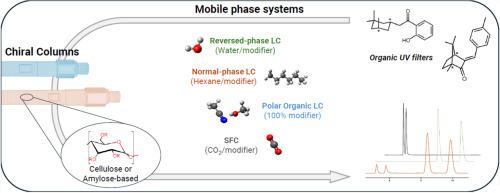From multimodal liquid chromatography to supercritical fluid chromatography: Mapping chiral separation of the major organic ultraviolet filters
IF 3.2
引用次数: 0
Abstract
The widespread presence of chiral organic UV filters in the environment raises critical concerns due to their potential enantioselective toxicity and persistence. This study provides the first comprehensive enantioseparation screening of five such compounds – enzacamene, homosalate, octinoxate, octisalate, and octocrylene – using multimodal liquid chromatography (LC), as well as supercritical fluid chromatography (SFC) with 20 polysaccharide-based chiral stationary phases (CSPs). Enzacamene and homosalate were baseline-resolved across all tested conditions, including SFC, while octisalate showed separation in normal and reversed-phase modes. Octinoxate was resolved only in normal-phase mode, and octocrylene was not fully resolved, though near-baseline separation was achieved in polar organic and normal-phase modes. SFC, particularly with non-conventional CO₂/hexane–ethanol eluent, proved complementary to LC, achieving comparable or superior enantioresolution. Coated amylose columns demonstrated superior performance in reversed-phase mode, whereas immobilized CSPs, particularly chloromethylphenylcarbamate-based selectors, displayed broader applicability across multiple mobile phase systems. These findings emphasize the necessity of multimodal approaches to optimize the enantioseparation of highly lipophilic environmental contaminants and establish a robust analytical foundation for future ecotoxicological and regulatory studies.

从多模态液相色谱到超临界流体色谱:主要有机紫外滤光片的手性分离图谱
由于其潜在的对映选择性毒性和持久性,手性有机紫外线过滤器在环境中的广泛存在引起了人们的严重关注。本研究首次利用多模态液相色谱(LC)和超临界流体色谱(SFC)对20种基于多糖的手性固定相(csp)进行了对5种此类化合物(enzacamene、homosalate、octinoxate、octisalate和octocrylene)的对映体分离筛选。Enzacamene和homosalate在包括SFC在内的所有测试条件下均可基线分离,而occissalate在正相和反相模式下均可分离。虽然在极性有机和正相模式下实现了接近基线的分离,但辛酸盐仅在正相模式下被分解,而八烯没有完全被分解。SFC,特别是非常规CO 2 /己烷-乙醇洗脱液,被证明与LC互补,实现相当或更好的对映体分辨率。包被直链淀粉柱在反相模式下表现出优越的性能,而固定化csp,特别是基于氯甲基苯基氨基甲酸酯的选择器,在多个流动相系统中表现出更广泛的适用性。这些发现强调了多模态方法优化高亲脂性环境污染物对构象分离的必要性,并为未来的生态毒理学和调控研究奠定了坚实的分析基础。
本文章由计算机程序翻译,如有差异,请以英文原文为准。
求助全文
约1分钟内获得全文
求助全文
来源期刊

Journal of chromatography open
Analytical Chemistry
CiteScore
2.50
自引率
0.00%
发文量
0
审稿时长
50 days
 求助内容:
求助内容: 应助结果提醒方式:
应助结果提醒方式:


